| Season Start: | 30 August 1975 | | Season End: | 06 March 1976 | | Season Length: | 28 Weeks | | Actual Weeks: | 26 Weeks | | Writers: | Louis Marks, Robert Banks Stewart, Robin Bland, Stephen Harris and Terry Nation | | Directors: | Barry Letts, Christopher Barry, David Maloney, Douglas Camfield and Paddy Russell | | Producer: | Philip Hinchcliffe | | Script Editor: | Robert Holmes | | Visual Effects: | Dave Havard, Ian Scoones, John Friedlander, John Horton, Len Hutton and Richard Conway | | Title Sequence: | Bernard Lodge | | Title Music: | Ron Grainer and the BBC Radiophonic Workshop. Arranged by Delia Derbyshire |
|
Incarnation of the Doctor: |
The Fourth Doctor
|
| Number of
Companions: |
4 |
| The
Companions: |
The Brigadier (Departs), Sergeant Benton (Departs), Sarah Jane Smith and Harry Sullivan (Departs)
|
| Number of
Stories: |
6
|
| Number of
Incomplete/Missing Stories: |
0
|
| Number of
Episodes: |
26
|
| Number of
Incomplete/Missing Episodes: |
0
|
| Percentages: |
| Full Stories Held | 100% | | Episodes Held | 100% |
|
| Doctor Who Magazine Poll (1998) | | | Doctor Who Magazine Poll (2009) | | | Doctor Who Magazine Poll (2014) | |
|
 'Something's interfering with time, Mr. Scarman. And time is my business.' 'Something's interfering with time, Mr. Scarman. And time is my business.'
The Doctor
(Pyramids of Mars) |
|
|
|
|
| |
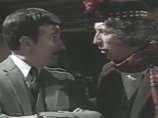 |
| The Brigadier Calls The Doctor |
|
 The thirteenth season of Doctor Who started on the 30th August 1975 – just 16 weeks after Season Twelve finished. This start in the autumn was something that had not happened in the show, since 1968 with Season Six, and was done in order to get a jump on rival ITV's lavish new science-fiction drama, Space: 1999. This was the first full season to be headed by Producer Philip Hinchcliffe and Script Editor Robert Holmes. The thirteenth season of Doctor Who started on the 30th August 1975 – just 16 weeks after Season Twelve finished. This start in the autumn was something that had not happened in the show, since 1968 with Season Six, and was done in order to get a jump on rival ITV's lavish new science-fiction drama, Space: 1999. This was the first full season to be headed by Producer Philip Hinchcliffe and Script Editor Robert Holmes.
 For those watching the show at the time could not have not noticed that the themes of all the stories were heavily influenced by classic horror and science fiction films. With "Planet of Evil" being the first of the ‘gothic horror’ stories that became the hallmark of Philip Hinchcliffe. For those watching the show at the time could not have not noticed that the themes of all the stories were heavily influenced by classic horror and science fiction films. With "Planet of Evil" being the first of the ‘gothic horror’ stories that became the hallmark of Philip Hinchcliffe.
 Consisting of 6 stories and 26 episodes this season started with "Terror of the Zygons" which was the final story made as part of the twelfth recording block. Despite being a popular part of the show, throughout the whole of the Third Doctor’s era, this season saw The Doctor cutting ties with UNIT. Even though three stories featured UNIT ("Terror of the Zygons", "The Android Invasion" and "The Seeds of Doom", of the regular UNIT characters only Benton and Harry Sullivan appeared in "The Android Invasion" and none appeared in "The Seeds of Doom". This last story of the season marked the final notable appearance or reference to UNIT until the 1982 Fifth Doctor story "Time-Flight". Consisting of 6 stories and 26 episodes this season started with "Terror of the Zygons" which was the final story made as part of the twelfth recording block. Despite being a popular part of the show, throughout the whole of the Third Doctor’s era, this season saw The Doctor cutting ties with UNIT. Even though three stories featured UNIT ("Terror of the Zygons", "The Android Invasion" and "The Seeds of Doom", of the regular UNIT characters only Benton and Harry Sullivan appeared in "The Android Invasion" and none appeared in "The Seeds of Doom". This last story of the season marked the final notable appearance or reference to UNIT until the 1982 Fifth Doctor story "Time-Flight".
 "The Seeds of Doom" also marked the last occasion that The Doctor is explicitly said to be working for UNIT - as opposed to working with them as occasions warranted – and after "Terror of the Zygons" the popular semi-regular character, The Brigadier, would not appear again until the 1983 Fifth Doctor story "Mawdryn Undead". The Brigadier and Sergeant Benton had appeared in all the previous seasons since Season Five (for The Brigadier) and Season Six (for Sergeant Benton). "The Seeds of Doom" also marked the last occasion that The Doctor is explicitly said to be working for UNIT - as opposed to working with them as occasions warranted – and after "Terror of the Zygons" the popular semi-regular character, The Brigadier, would not appear again until the 1983 Fifth Doctor story "Mawdryn Undead". The Brigadier and Sergeant Benton had appeared in all the previous seasons since Season Five (for The Brigadier) and Season Six (for Sergeant Benton).
 "Terror of the Zygons" was also the final story to feature Harry Sullivan as a regular cast member, although Ian Marter, who played this companion, would later return briefly, as an android duplicate of Harry Sullivan, in "The Android Invasion". The character of Harry Sullivan would return to assist the Fourth Doctor in the BBC Books' The Past Doctors Stories novels "System Shock" and "Millennium Shock" by Justin Richards. He was also mentioned in "Mawdryn Undead" in which Harry is said to be working for NATO. With Harry Sullivan’s departure The Doctor would not have another male companion until Adric's arrival in the 1980 story "Full Circle" in Season Eighteen. "Terror of the Zygons" was also the final story to feature Harry Sullivan as a regular cast member, although Ian Marter, who played this companion, would later return briefly, as an android duplicate of Harry Sullivan, in "The Android Invasion". The character of Harry Sullivan would return to assist the Fourth Doctor in the BBC Books' The Past Doctors Stories novels "System Shock" and "Millennium Shock" by Justin Richards. He was also mentioned in "Mawdryn Undead" in which Harry is said to be working for NATO. With Harry Sullivan’s departure The Doctor would not have another male companion until Adric's arrival in the 1980 story "Full Circle" in Season Eighteen.
 Ian Marter continued to maintain a connection to the show. He went on to write several novelisations of Doctor Who stories for Target Books (including some in which he had appeared as Harry Sullivan) and he also authored an original Harry Sullivan spin-off novel, "Harry Sullivan's War", for Target's short-lived The Companions of Doctor Who range. Ian Marter also continued to act on stage and television, earning credits on programmes such as Bergerac and The Return of Sherlock Holmes. Sadly he died in October 1986. Ian Marter continued to maintain a connection to the show. He went on to write several novelisations of Doctor Who stories for Target Books (including some in which he had appeared as Harry Sullivan) and he also authored an original Harry Sullivan spin-off novel, "Harry Sullivan's War", for Target's short-lived The Companions of Doctor Who range. Ian Marter also continued to act on stage and television, earning credits on programmes such as Bergerac and The Return of Sherlock Holmes. Sadly he died in October 1986.
 Several of the stories in this season, particularly "Pyramids of Mars" and "The Brain of Morbius", are among the best-known of the 1970s-era storylines and are considered by many fans as classics. As well as visiting the Earth the TARDIS took the Fourth Doctor and his companion, Sarah Jane Smith, to Mars ("Pyramids of Mars"), Karn ("The Brain of Morbius") and to the most distant planet in the galaxy ("Planet of Evil"). Several of the stories in this season, particularly "Pyramids of Mars" and "The Brain of Morbius", are among the best-known of the 1970s-era storylines and are considered by many fans as classics. As well as visiting the Earth the TARDIS took the Fourth Doctor and his companion, Sarah Jane Smith, to Mars ("Pyramids of Mars"), Karn ("The Brain of Morbius") and to the most distant planet in the galaxy ("Planet of Evil").
 Uniquely, all the stories in this season introduced new monsters to the show. None of whom have since made a reappearance on television. However, the Zygons and Morbius have though both returned in various books and audio stories. Neither the Daleks nor the Cybermen made an appearance in any of the stories during this season - the first time neither of these popular monsters appeared in a season since 1971 in Season Eight. Uniquely, all the stories in this season introduced new monsters to the show. None of whom have since made a reappearance on television. However, the Zygons and Morbius have though both returned in various books and audio stories. Neither the Daleks nor the Cybermen made an appearance in any of the stories during this season - the first time neither of these popular monsters appeared in a season since 1971 in Season Eight.
 Viewing figures increased as the season progressed peaking at 11.7 million for "The Android Invasion" before dropping off slightly for the last two stories. Ironically despite "The Android Invasion" being the most popular story when this season was first broadcast this particular story has received the least amount of votes, for a story in this season, in two Doctor Who Magazine polls. The most popular story, in these polls for this season, was "Pyramids of Mars" which today is seen as a classic Doctor Who story and one of the best for Tom Baker as the Fourth Doctor. Viewing figures increased as the season progressed peaking at 11.7 million for "The Android Invasion" before dropping off slightly for the last two stories. Ironically despite "The Android Invasion" being the most popular story when this season was first broadcast this particular story has received the least amount of votes, for a story in this season, in two Doctor Who Magazine polls. The most popular story, in these polls for this season, was "Pyramids of Mars" which today is seen as a classic Doctor Who story and one of the best for Tom Baker as the Fourth Doctor.
 However, amidst the show’s soaring popularity, a new problem for the BBC reared its head in the form of Mary Whitehouse and her National Viewers and Listeners Association (NVALA). A self-appointed media watchdog, Mary Whitehouse had at times spoken out against violence and horror in Doctor Who in the past. But with the Philip Hinchcliffe/Robert Holmes formula encouraging these very elements, Mary Whitehouse went on the offensive, ultimately contributing to the break-up of this very successful production team at the end of the following season. However, amidst the show’s soaring popularity, a new problem for the BBC reared its head in the form of Mary Whitehouse and her National Viewers and Listeners Association (NVALA). A self-appointed media watchdog, Mary Whitehouse had at times spoken out against violence and horror in Doctor Who in the past. But with the Philip Hinchcliffe/Robert Holmes formula encouraging these very elements, Mary Whitehouse went on the offensive, ultimately contributing to the break-up of this very successful production team at the end of the following season.
|
|
|
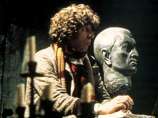 |
| The Doctor with Morbius' Clay Head |
|
 The most memorable part of this season is in "Pyramids of Mars" – especially in the chilling sequence when The Doctor takes his companion Sarah Jane Smith to an alternative 1980 to show her the destruction that Sutekh would wreak on the Earth if allowed to escape. This story also contains the classic line spoken by The Doctor when he tries to break through the barrier surrounding the priory. Who can forget The Doctor wielding his sonic screwdriver and telling Sarah Jane Smith: Deactivating a generator loop without the correct key is like repairing a watch with a hammer and chisel. One false move and you'll never know the time again’. The most memorable part of this season is in "Pyramids of Mars" – especially in the chilling sequence when The Doctor takes his companion Sarah Jane Smith to an alternative 1980 to show her the destruction that Sutekh would wreak on the Earth if allowed to escape. This story also contains the classic line spoken by The Doctor when he tries to break through the barrier surrounding the priory. Who can forget The Doctor wielding his sonic screwdriver and telling Sarah Jane Smith: Deactivating a generator loop without the correct key is like repairing a watch with a hammer and chisel. One false move and you'll never know the time again’.
 "The Brain of Morbius" reveals a bit more of the history of Gallifrey and introduced Morbius - the one-time leader of the High Council who tried to steer the Time Lords down a path towards destruction and conquest. This story was influenced by Mary Shelley's novel Frankenstein and includes scenes where Sarah Jane Smith is terrorised by the headless monster that the fanatical scientist, Solon, has created using body parts from survivors of the spaceships that have crashed on the planet Karn – including the arm of his loyal servant Condo. Containing a grotesque headless monster, a fanatical scientist, a blind Sarah and of course Morbius’ resurrection this story is truly a classic. "The Brain of Morbius" reveals a bit more of the history of Gallifrey and introduced Morbius - the one-time leader of the High Council who tried to steer the Time Lords down a path towards destruction and conquest. This story was influenced by Mary Shelley's novel Frankenstein and includes scenes where Sarah Jane Smith is terrorised by the headless monster that the fanatical scientist, Solon, has created using body parts from survivors of the spaceships that have crashed on the planet Karn – including the arm of his loyal servant Condo. Containing a grotesque headless monster, a fanatical scientist, a blind Sarah and of course Morbius’ resurrection this story is truly a classic.
 At the end of "The Brain of Morbius" The Doctor challenges Morbius to a mind-bending contest. During this scene images of The Doctor's previous three incarnations appear. Various other images also appear during this battle of wills. While the identity of these other faces are never explicitly stated there has been a long running speculation that these are earlier incarnations of The Doctor, that precede the First Doctor or they may be that of Morbius. Whichever, this is a scene worth watching. At the end of "The Brain of Morbius" The Doctor challenges Morbius to a mind-bending contest. During this scene images of The Doctor's previous three incarnations appear. Various other images also appear during this battle of wills. While the identity of these other faces are never explicitly stated there has been a long running speculation that these are earlier incarnations of The Doctor, that precede the First Doctor or they may be that of Morbius. Whichever, this is a scene worth watching.
|
|
|
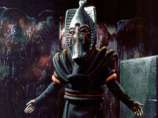 |
| Sutekh |
|
 "The Android Invasion" is the weak link in an otherwise outstanding season. This story has received decidedly mixed reviews over the years even though it was the most popular story when this season was first broadcast. Being a UNIT story it did not include The Brigadier as Nicholas Courtney was not available during the time this story was recorded. Sergeant Benton (who had been promoted to Warrant Officer in last season’s "Robot") and Harry Sullivan (played by John Levene and Ian Marter respectively) both appeared all-be-it very briefly. "The Android Invasion" is the weak link in an otherwise outstanding season. This story has received decidedly mixed reviews over the years even though it was the most popular story when this season was first broadcast. Being a UNIT story it did not include The Brigadier as Nicholas Courtney was not available during the time this story was recorded. Sergeant Benton (who had been promoted to Warrant Officer in last season’s "Robot") and Harry Sullivan (played by John Levene and Ian Marter respectively) both appeared all-be-it very briefly.
 What really lets this story down is the ending where Styggron accidentally infects himself during the fight with an android Doctor and is killed. The fate of Harry Sullivan, Sergeant Benton and the other replaced humans is also never fully revealed resulting in a very unsatisfactory ending on what could have been a brilliant story. What really lets this story down is the ending where Styggron accidentally infects himself during the fight with an android Doctor and is killed. The fate of Harry Sullivan, Sergeant Benton and the other replaced humans is also never fully revealed resulting in a very unsatisfactory ending on what could have been a brilliant story.
 The highest point of this season is "Pyramids of Mars". This story starts with the scenes where Professor Marcus Scarman, an archaeologist and Egyptologist, breaks into a tomb in Egypt not realising that this is the prison belonging to Sutekh the Destroyer, an Osiran who was worshipped as a god by the ancient Egyptians. Sutekh though plans to walk the Earth again and he uses Professor Scarman to act on his behalf to construct a rocket that will destroy the controlling signal emanating from a pyramid on Mars. But Sutekh is hindered by The Doctor. The highest point of this season is "Pyramids of Mars". This story starts with the scenes where Professor Marcus Scarman, an archaeologist and Egyptologist, breaks into a tomb in Egypt not realising that this is the prison belonging to Sutekh the Destroyer, an Osiran who was worshipped as a god by the ancient Egyptians. Sutekh though plans to walk the Earth again and he uses Professor Scarman to act on his behalf to construct a rocket that will destroy the controlling signal emanating from a pyramid on Mars. But Sutekh is hindered by The Doctor.
 The Doctor, aided by Sarah Jane Smith and Professor Scarman’s brother Laurence Scarman, does everything he can to thwart Sutekh. After being chased by robots disguised as Mummies, shot at and then coming under Sutekh's control and forced to transport Professor Scarman to Mars, it seems that The Doctor may have met his match with Sutekh. But then of course The Doctor is a master of time… The Doctor, aided by Sarah Jane Smith and Professor Scarman’s brother Laurence Scarman, does everything he can to thwart Sutekh. After being chased by robots disguised as Mummies, shot at and then coming under Sutekh's control and forced to transport Professor Scarman to Mars, it seems that The Doctor may have met his match with Sutekh. But then of course The Doctor is a master of time…
|
|
|
|
|
| |
The Firsts:
 The first (and only) appearance of the Zygons. (Terror of the Zygons) The first (and only) appearance of the Zygons. (Terror of the Zygons)
 The first ‘gothic horror’ story that became the hallmark of this era’s producer, Philip Hinchcliffe. (Planet of Evil) The first ‘gothic horror’ story that became the hallmark of this era’s producer, Philip Hinchcliffe. (Planet of Evil)
 The first (and only) appearance of Sutekh. (Pyramids of Mars) The first (and only) appearance of Sutekh. (Pyramids of Mars)
 The first non-Dalek story to be written by Terry Nation since the 1964 First Doctor story "The Keys of Marinus". (The Android Invasion) The first non-Dalek story to be written by Terry Nation since the 1964 First Doctor story "The Keys of Marinus". (The Android Invasion)
 The first (and only) Doctor Who story to have a heavily edited omnibus home-video release. (The Brain of Morbius) The first (and only) Doctor Who story to have a heavily edited omnibus home-video release. (The Brain of Morbius)
|
| |
The Lasts (Subject to Future Stories):
| |
| Doctor Who CMS Magazine (In Vision) | Issue 14: Season 13 Overview - (Released: March 1989) | | Doctor Who Magazine - Article | Issue 124 - (Released: May 1987) | | Doctor Who Magazine - Episode Guide | Issue 150 - (Released: July 1989) | | Doctor Who Magazine - Article | Issue 290 - (Released: May 2000) | | Doctor Who Magazine - Countdown to 50 | Issue 442 - (Released: December 2011/January 2012) |
|
|
| |
The Doctor and Companions| | 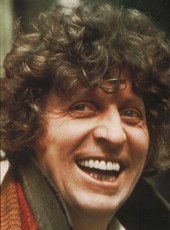 | | The Fourth Doctor |
|
| | | | |
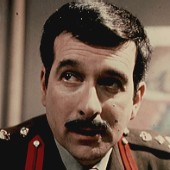 | | The Brigadier |
| 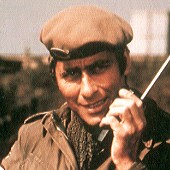 | | Sergeant Benton |
|  | | Sarah Jane Smith |
| | | | |  | | Harry Sullivan |
|
|
On Release| |  | | The Collection Season 13 Limited Edition Blu-Ray Cover |

VIDEO |
| | | | | |
Magazines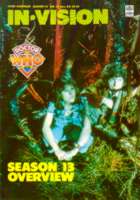 | | Doctor Who CMS Magazine (In Vision): Issue 14: Season 13 Overview |
|  | | Doctor Who Magazine - Article: Issue 124 |
|  | | Doctor Who Magazine - Episode Guide: Issue 150 |
|  | | Doctor Who Magazine - Article: Issue 290 |
| | | | |  | | Doctor Who Magazine - Countdown to 50: Issue 442 |
|
|
|
|
| |
| |
|
| |
| |
|
| Doctor Who is the copyright of the British Broadcasting
Corporation. No infringements intended. This site is not endorsed by the BBC or
any representatives thereof. |
|